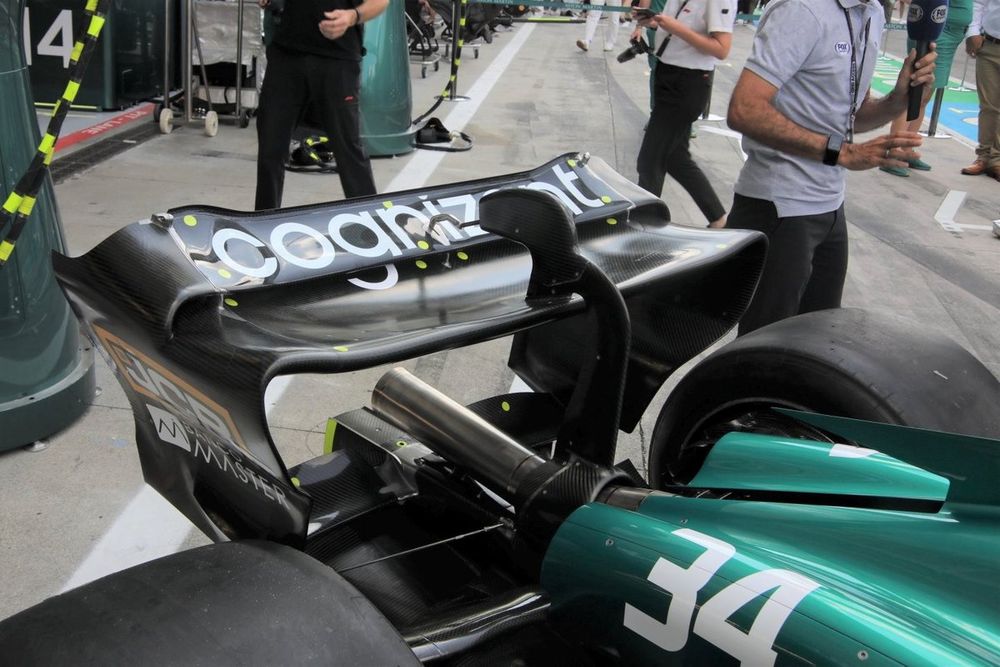
While there are other high-speed tracks on the F1 calendar, the ‘Temple of Speed’ remains an outlier because so much of it is straights, and this necessitates a standalone downforce package.
But the approach of teams is not uniform, as some have gone the extra mile in delivering a new package while others, perhaps limited by the cost cap, have made some more ad hoc tweaks.


Red Bull, which we already know has somewhat of an advantage in terms of straight-line speed, has a couple of rear wing solutions at its disposal.
The lower downforce version has an upper flap that’s been trimmed and has a removable Gurney fixed to the trailing edge. Meanwhile, a more uniform trailing edge can be found on its other solution, albeit there is a V-groove cutout in the central section.
Trimming the upper flap’s trailing edge is obviously a cost-effective approach in this situation but it’s one of compromise, as the wing wasn’t designed expressly for this purpose.
And, whilst a boost in straight-line speed is to be expected, it will come at the expense of how the wing performs when DRS is in use.
The teams does have another method with which to balance the downforce and drag levels at the rear of the car too, with the beam wing offering aerodynamic support between the rear wing and diffuser.

Of course, it’s not only about the rear of the car when it comes to downforce and drag levels. Teams also have to be conscious of being able to balance their needs front-to-rear, with Red Bull also making an effort to trim the front wing’s upper flap in order to cater for this.
Mercedes has also opted for a low downforce, low drag rear wing and beam wing combination for Monza, the upper elements of which follow a similar trend to the arrangements we’ve seen in the past, including a trimmed trailing edge of the upper flap, albeit without the Gurney seen on the Red Bull.
Meanwhile, the endplate infill panels have also returned, as the team has clearly identified this as a mechanism to provide the necessary balance between downforce and drag at lower downforce venues.

An interesting feature of this, although we have seen it do so before, is the upper edge of the infill panel has also been trimmed, resulting in a small surface step to accommodate the DRS pivot.
It’s also noteworthy that Mercedes has opted for just a single element beam wing, which is something we’ve seen the likes of Red Bull and Williams use as a method to trim their downforce and drag levels throughout the course of this season already.

Aston Martin also has a solution on the lower end of its downforce spectrum, whilst the team has opted to trim the trailing edge of its upper flap and add a Gurney flap to help reduce downforce and drag.
It has paired this with just a single element beam wing, albeit it does have quite a large chord when compared with some of the double element arrangements.
Ferrari has opted for a circuit specific rear wing design at Monza, as it looks for ways to boost its straight-line speed relative to rivals.


The design features a much flatter mainplane than teams would ordinarily opt for with these regulations, with the spoon-shaped variant most regularly deployed in order to help balance downforce and drag levels.
This new arrangement also has a shallow angle of attack but boasts quite a large upper flap to help maintain the DRS effect when it’s in use.
To help balance the car front-to-rear, Ferrari has also trimmed the front wing’s upper flap quite significantly too.
McLaren used its time during FP1 to evaluate two rear and beam wing configurations on its cars, with flo-viz also applied to both as a means for the team to capture visual confirmation of their behaviour.


The solutions presented are quite different to one another, with Lando Norris’ MCL60 (left image) furnished with what appears to be a slightly higher downforce configuration, owing to the spoon-shaped layout of the mainplane. However, the trailing edge of the upper flap has been trimmed to marry with the lower profile.
McLaren has, for the first time, employed a design pioneered by Alpine but more extensively used by Mercedes, whereby an infill panel is placed in the endplate cutout section.
Comparably you’ll also note that the lowermost beam wing element on Norris’ car has been backed off significantly, when compared with the one on Piastri’s car, illustrating how the rear wing and beam wing elements can be used in tandem to balance their performance.
Alfa Romeo has what might be considered one of the most interesting designs to have surfaced this weekend as it combines a number of captivating solutions.


Notably, like the Ferrari design, it has an almost flat mainplane surface but also features a design solution we saw earlier in the season from Alpine, whereby the leading edge is stepped back relative to the leading edge of the endplate, in order it doesn’t take up the full allotted space allowed within the box region.
The swan neck-style twin pillars used to help support the wing are also quite novel, not only as they must extend further rearwards to meet with the mainplane but also due to how low they are when compared with the regular design.
The rear section of the pillar has also been chamfered to reduce any aerodynamic interference they might cause to the mainplane and upper flap.


Alpine is also deploying the aforementioned leading-edge configuration this weekend, having previously utilised it at the Azerbaijan Grand Prix.
Perhaps most interestingly though, it fixed tufts, rather than use flo-viz, to the underside of its rear wing and beam wing during FP1, which is an old-school technique used by teams, to help it understand the aerodynamic behaviour of those elements.







